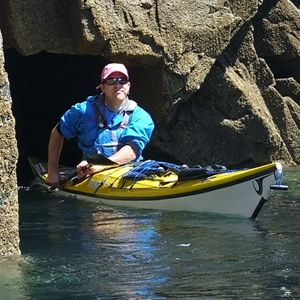It's unusual to be excited by anything on a university reading list. Whilst most of the recommended books were pretty dull, one of them was a picture book, and it spoke to some of the excitement and mystery that some of us wide-eyed freshers still associated with studying engineering.
Milton Van Dyke's An Album of Fluid Motion [1] is a collection of pictures of flowing liquids and gases. It's both beautiful and fascinating. It seems to now be out of print, but the whole thing can now be found online. The front page features this image:
 It shows vortices in water flowing past a 1 cm cylinder. Tiny white particles injected into the fluid and illuminated by a sheet of light are used to reveal the shape of the flow. Eddies form behind the cylinder as the water flows by, but these periodically detach from the cylinder, being carried downstream by the flow. One eddy detaches from the right side, the next from the left, forming a periodic pattern known as a 'Von Karman vortex street'. You can see an animation of the process here.
It shows vortices in water flowing past a 1 cm cylinder. Tiny white particles injected into the fluid and illuminated by a sheet of light are used to reveal the shape of the flow. Eddies form behind the cylinder as the water flows by, but these periodically detach from the cylinder, being carried downstream by the flow. One eddy detaches from the right side, the next from the left, forming a periodic pattern known as a 'Von Karman vortex street'. You can see an animation of the process here.
It turns out that this process of vortex shedding is ubiquitous in nature.
 The images show vortices behind a rock in a Scottish River, a Canadian Island [2] and the Great Red Spot on Jupiter. If we include the first image of a 1 cm cylinder, the scales of these flows differ by 9 orders of magnitude.
The images show vortices behind a rock in a Scottish River, a Canadian Island [2] and the Great Red Spot on Jupiter. If we include the first image of a 1 cm cylinder, the scales of these flows differ by 9 orders of magnitude.
Equally as remarkable is that the way that these vortices behave tends to be fairly consistent across a wide range of scales and flow speeds - typically the distance between successive vortices on one side of the obstruction will be around 5 times the size of the obstruction. Studies [2,3] show this is true for islands in tidal streams. Interestingly, there's a somewhat open question as to exactly when these vortex streets occur - it turns out that friction with the seabed tends to prevent them occurring when flows are slow and the water is shallow [2].
As sea kayakers, we experience these vortices in different ways, depending on how big they are.
At the smallest scale, we might found ourselves bounced around in a less-than-persistant eddy behind a small object, like a navigation buoy, in a tidal stream.
At a slightly larger scale, we call these vortices 'whirlpools' where they reach the surface. They can make for challenging conditions in fast-moving tide races, like the Falls of Lora.

Falls of Lora from the air [4] showing periodic vortex/whirlpool structure at the edges of the stream and from the bridge pillar [5], giving a feel of the scale of the flow.
At a larger scale, vortex shedding likely results in unsteady flow in tidal streams, perhaps over a timescale of several minutes. Local paddlers have described a variation in the speed of the water in the Swellies area of the Menai Strait during north-east going spring tides, with a timescale of around 7 minutes. It makes sense that this only occurs on the stream in this direction - there's not a lot upstream of the Swellies on the south-west going flow, and no area where the stream would decelerate markedly. However, the water on the north-east going flow is squeezed past Abermenai point, a feature behind which a vortex street might well form, and which is of about the right size (~200 m) to cause the length of flow variation reported. It might be thought that any whirlpool-like features would have dissipated by the time the flow reaches the Swellies, but it turns out that vortices can be quite stable as they pass along channels [6].
References:
[1]: Van Dyke, Milton, and Milton Van Dyke. An album of fluid motion. Vol. 176. Stanford: Parabolic Press, 1982.
[2]: Ingram, R. Grant, and Vincent H. Chu. "Flow around islands in Rupert Bay: An investigation of the bottom friction effect." Journal of Geophysical Research: Oceans 92.C13 (1987): 14521-14533.
[3]: Neill, Simon P., and Alan J. Elliott. "Observations and simulations of an unsteady island wake in the Firth of Forth, Scotland." Ocean Dynamics 54.3-4 (2004): 324-332.
[4]: Image by Hebridean Air Services Ltd, from: https://www.hebrideanair.co.uk/clients
[5]: Image from Alchetron (https://alchetron.com/Falls-of-Lora)
[6]: Wang, Xiaolin, and Silas Alben. "The dynamics of vortex streets in channels." Physics of Fluids 27.7 (2015).
